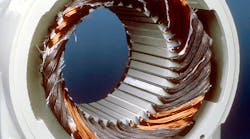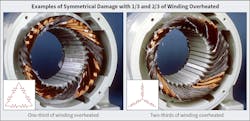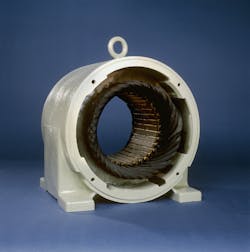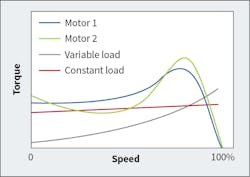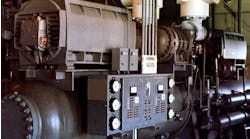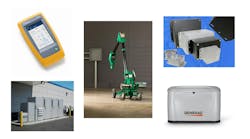How to Troubleshoot AC Induction Motors Effectively
Small and medium AC induction motors account for more than 75% of motor electrical energy demand; however, they typically receive less maintenance than their larger counterparts. This leaves them vulnerable to unexpected failures and costly downtime. Besides providing some basic troubleshooting tips for these machines, this article explores common motor symptoms, associated problems, and when to involve an electric motor service center.
Definitions of small, medium, and large motors vary by standard and manufacturer, but this discussion uses the values in Table 1.
Starting
No power — If the motor fails to start and there is no rotation, electrical humming noise, or signs of heating, tripped overload relays are the most likely issue. While it is permissible to reset the relays and start the motor, always investigate the cause of the trip — even when the motor operates normally after the start.
If the relays have not tripped, investigate the motor’s power supply. If the input voltage is okay, perform diagnostic testing on the motor.
Power, but no rotation — If the shaft fails to rotate, and the motor emits a humming noise or shows signs of heating, shut off the power immediately. In a stationary position at rated voltage and frequency, an induction motor will undergo significant heating that can damage components quickly.
This condition can occur if the motor input circuit is in a single-phased condition and thus unable to produce a rotating magnetic field and an accompanying accelerating torque. A technician can verify this by checking the input line-to-line voltages, which should be balanced and within 10% of the motor’s rated voltage.
If the motor previously has operated in a single-phased condition, it will have experienced significant heating and may have operated until an operator shut it down. If the motor winding is single-phased, restarting will not be possible. Inspection usually will confirm this condition with one-third or two-thirds of the winding discolored, but this requires at least partial disassembly (Photo 1).
If the motor is locked mechanically, uncouple it from the load, and turn the shaft manually to determine if the bind is due to the driven equipment, the motor bearings, or the rotor. A smooth manual rotation of the motor shaft indicates an issue with the driven load.
Trips — If the overload relays are tripping during starting, there are a couple of potential issues. First, verify that the relays are the size specified by code for the motor’s nameplate current and service factor. Additionally, when replacing an old motor with a new one, check the starting current. Newer motors with higher efficiency ratings tend to have significantly higher starting current than their older counterparts. Evaluating starting current should be part of the procurement process, but many organizations miss this.
One advantage of solid-state overload relays over the bimetallic type is that they often allow for adjustment of the trip class, which gives some flexibility in starting characteristics for different motors in an application.
Low acceleration — Lower than rated supply voltage magnitude or excessive voltage drop during starting will reduce the motor’s accelerating torque. Torque is roughly proportional to the square of the voltage, so a 10% voltage reduction will reduce torque by 20%.
A variable-voltage, fixed-frequency starter (e.g., wye-delta, part-winding, autotransformer, or electronic soft start) will reduce the accelerating torque. Often, this is desired. However, if the acceleration time is too long, it will be necessary to reduce the starting load, use a larger motor, or modify the starting method. On the other hand, using a variable-voltage, variable-frequency drive (VFD) will allow for much more controlled acceleration without sacrificing accelerating torque.
Many small and medium induction motors are manufactured with six, nine, or 12 winding terminals to facilitate use with various supply voltages and starting methods. Misconnecting the motor to the supply lines commonly causes low acceleration. For example, a 12-lead motor may be configured for connection to a 230V supply or 460V supply and be suitable for wye-delta starting on either voltage or part-winding starting on 230V. However, if the motor is designed to start direct online for 230V but is instead connected for 460V (or connected wye when it should be delta), it will be significantly weaker than intended. In some cases, it will run for some time and fail with an appearance of overload (Photo 2); in other cases, it will not start. Note that connecting the motor for 230V when it should be 460V (or connecting it delta when it should be wye) will have the opposite effect — very high starting current likely to trip on start.
Running
Overheating — Most electric motors are manufactured with a specified maximum ambient temperature of 40°C (104°F). While maximum allowable temperatures vary by standard, motor size, service factor, rated voltage, and method of measurement, they will be near the motor’s insulation system thermal class (Table 2).
The surface or skin temperature of electric motors varies widely by design. Absent guidance from the manufacturer, it is usually not a reliable location to evaluate winding temperature rise. However, comparing skin temperature with data from previous measurements (or other identical motors in the same application) may be helpful. Embedded detectors like thermistors, resistance temperature detectors (RTDs), or thermostats are much better options for evaluating winding temperature. While thermostats cannot provide numerical data, they can indicate a specific temperature has been reached. Many small and medium motors might not be equipped with embedded temperature detectors, but a service center can add them.
If a motor is overheating, first verify that the input current in all three phases does not exceed the motor’s ratings. If it is overloaded, either reduce the load enough that the total winding temperature is within permissible limits, or install a motor with an appropriate output rating. Sometimes service centers can redesign machines to alleviate the problem.
Excessive starting or exceeding a motor’s rated duty cycle also can cause overheating. Both topics are beyond the scope of this article but merit evaluation when selecting a motor for an application or investigating an overheating problem. A qualified service center can help end-users with these tasks.
Another common cause of overheating is poor ventilation. The installation and maintenance manuals for new motors usually describe the ventilation requirements for proper operation. Common issues include installing the motor too close to walls, structures, or other equipment that restricts the flow of cooling air or increases the ambient temperature.
Very low operating speed — Sometimes, a motor starts but runs well below its rated speed when supplied with rated voltage/frequency. This usually trips an overload relay (based on its current setting and trip class), but the behavior should be observable before the trip. Significant overload is a common cause of this condition, but others are worth mentioning.
The Figure shows speed-torque curves for two different motors with the same horsepower (kilowatt) rating and the same number of poles, along with two load-torque curves — one for constant torque and one for variable torque. Relative to the load-torque curves, Motor 1 has a positive accelerating torque from zero speed to normal running speed, so it would accelerate either load up to the intersection of the speed-torque and load-torque curve.
Although Motor 2 has greater starting torque (torque at zero speed) and greater breakdown torque (maximum torque) than Motor 1, it has a lower pull-up torque (minimum torque between locked-rotor and breakdown). Since its speed-torque curve intersects the constant-load torque curve between locked-rotor and breakdown, Motor 2 would operate at that point and accelerate no further. Either motor would accelerate the variable-torque load.
The scenario that the Figure presents can be puzzling to encounter because the basic performance data (starting and breakdown torque) might seem “stronger” for Motor 2 than Motor 1, even though both motors have almost the same nameplate data. This potential issue is more likely with medium and large motors than small motors and requires comparative pull-up torque values to identify.
Remember that even though it is generally permissible to operate small and medium motors as low as 90% of rated voltage, the roughly 20% reduction in torque could prevent acceleration of an appreciable load.
High vibration/noise — High vibration levels or mechanical noise are often caused by improper mounting or a change in mounting of the motor or driven equipment. These issues can often be resolved by ensuring that foundations are rigid, motor feet are co-planar (properly shimmed if needed), and fasteners are tightened properly.
Other common causes of high vibration or mechanical noise include an out-of-balance condition in either the motor, coupling (sheave), or driven load. Determine the source of imbalance by operating the motor uncoupled from the load with the coupling (or sheave) installed and then, if necessary, without it. Next, verify the alignment between the motor shaft and driven load, and correct it if needed. A less common issue is a resonance in the mounted system that requires dampening or modification to resolve.
Vibration analysis with a spectrum analyzer can save a lot of time in determining the issue and the best course of action. If plant maintenance personnel are not trained and equipped to perform the analysis, it’s usually worthwhile to contact a service center for assistance.
Bearing noise — Most small and medium induction motors have rolling element bearings (the types considered here). Once these bearings become noisy, they are damaged and should be replaced. When replacing damaged bearings, however, invest the time to determine the cause. Any of the conditions described under “high vibration/noise” above could lead to bearing failure.
Additionally, either loose or tight internal fit will reduce bearing life. This includes bearing housings and shaft bearing journals that are too large or small — or less commonly a bearing manufactured out of tolerance. Bearings last longest when they are mounted and lubricated correctly and protected from foreign materials, including water and dirt. But rolling element bearings have finite lives that generally decrease with increasing load or higher speed. So, expect them to fail at some interval, regardless of application, environment or mounting quality. It’s also worth mentioning that many more bearings fail due to over-lubrication than under-lubrication.
When to seek help
Reliability — Motors are expensive assets, and, in many applications, unplanned downtime exceeds the cost of the motor exponentially. When feasible, systems analysis should include condition monitoring to prevent failures and unplanned downtime.
Online or real-time data monitoring that can accurately diagnose potential or developing faults within a system is preferred. Where measurement of parameters is impossible or cost-prohibitive, use preventive and then corrective maintenance approaches. Based on condition monitoring and consistent with industry standards, typical decisions would include:
- No action; continue routine monitoring.
- Reduce the interval to the next required measurement.
- Change the machine load, speed, or throughput.
- Shut down the machine.
- Inspect the machine or bring forward planned maintenance.
- Carry out corrective maintenance.
A qualified service center can help you establish maintenance practices that improve system reliability.
Diagnostic tools — Many diagnostic tools are available for testing electric motors and vary widely in cost, function, and learning curve. End-user needs also vary widely depending on their maintenance personnel, motor population, and reliability program. Before investing in test equipment, spend sufficient time learning what it can and cannot do and how its capabilities support your objectives. A qualified service center can be helpful with these evaluations and recommendations.
And remember, it is not always necessary to diagnose a problem initially — just knowing something is wrong can often prevent catastrophic failures. For example, a wireless vibration/temperature sensor can alert you to vibration or temperature changes without assessing the nature of the vibration or correlating the motor surface temperature with the winding temperature. Maintenance personnel should follow advancements in the Industrial Internet of Things (IIoT) but proceed cautiously because online systems pose cybersecurity threats.
A few other technologies that maintenance personnel should become familiar with (even if the purchase is currently out of the question) include motor circuit analysis (MCA), infrared thermography (IRT), and motion amplification. Service center personnel interact with a variety of customers and see many different installations, technologies, and maintenance strategies. So, don’t hesitate to solicit their advice before making a decision.
Mike Howell is a technical support specialist at EASA, Inc., St. Louis, www.easa.com. EASA is an international trade association of more 1,700 firms in nearly 70 countries that sell and service electromechanical apparatus. He can be reached at [email protected].
